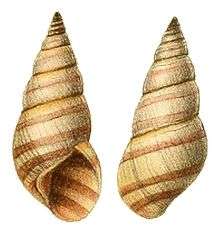Cerastidae
Cerastidae is a family of air-breathing land snails, terrestrial pulmonate gastropod mollusks in the order Stylommatophora.
| Cerastidae | |
|---|---|
 | |
| Drawing of apertural and abapertural view of the shell of Rhachistia rhodotaenia. | |
| Scientific classification | |
| Kingdom: | |
| Phylum: | |
| Class: | |
| Order: | |
| Suborder: | Helicina |
| Infraorder: | Pupilloidei |
| Superfamily: | Pupilloidea |
| Family: | Cerastidae |
| Synonyms | |
|
Pachnodidae Steenberg, 1925 | |
Genera
- Achatinelloides Nevill, 1878[2]
- Altenaia Zilch, 1972
- Amimopina Solem, 1964[3]
- Archeorachis Schileyko, 1998
- Cerastus E. von Martens, 1860
- Conulinus E. von Martens, 1895
- Darwininitium Budha & Mordan, 2012
- Euryptyxis P. Fischer, 1883
- Gittenedouardia Bank & Menkhorst, 2008[4]
- Hoqia Neubert, 2005[5]
- Limicena Connolly, 1925[6]
- Microscintilla Neubert, 2002[7]
- Nesiocerastus Van Mol & Coppois, 1980
- Nesobia Ancey, 1887
- Pachnodus E. von Martens, 1860
- Paracerastus Thiele, 1934
- Passamaella Clessin, 1878[8]
- Pleurorhachis Connolly, 1938
- Polychordia Connolly, 1941
- Rachis Albers, 1850[9]
- Rhachidina Thiele, 1911[10]
- Rhachistia Connolly, 1925[6]
- Soqena Neubert, 2005[5]
- Zebrinops Thiele, 1931
Description
Anatomically speaking, there is no flagellum in the reproductive system of snails in the family Cerastidae, and this is what distinguishes this family from its sister group the family Enidae.[11]
gollark: Do I need to switch it to binary mode and is there a way around the only reading by bytes thing?
gollark: I'm doing this with `"w"` and `"r"` mode instead of actual binary ones, because it's worked before and because `"wb"` and whatever seemingly only allow reading by bytes which would be really inconvenient.
gollark: So, basically, a new potatOS feature writes very long binary strings to files.
gollark: Luca_S, can you help me with something?
gollark: It's not compression on downloads, it's compression on storage.
References
- Wenz, W. (1923). Fossilium Catalogus I: Animalia. Gastropoda extramarina tertiaria. Berlin: W. Junk.
- Nevill, G. (1878). Hand List of Mollusca in the Indian Museum, Calcutta. Part I. Gastropoda. Pulmonata and Prosobranchia-Neurobranchia. Calcutta: Trustees of the Indian Museum.
- Solem, A. (1964). Aminopina, an Australian enid land snail. The Veliger, 6(3), 115–120.
- Bank, R. A. & Menkhorst, H. P. (2008). Notes on the nomenclature of some land- and freshwater molluscs of the Seychelles, with consequences for taxa from Africa, Madagascar, India, the Philippines, Jamaica, and Europe. Basteria, 72, 93–110.
- Neubert, E. (2005). The continental malacofauna of Arabia and adjacent areas. IV. Revision of the family Cerastidae in the Soqotran Archipelago. I. The genus Passamaella Pfeiffer, 1877, with a description of a new genus and species (Gastropoda: Pulmonata: Cerastidae). Archiv für Molluskenkunde, 134(1), 1–21.
- Connolly, M. (1925). The non-marine Mollusca of Portuguese East Africa. Transactions of the Royal Society of South Africa, 12, 105–220.
- Neubert, E. (2002). The continental malacofauna of Arabia and adjacent areas. I. Terrestrial molluscs of Samha and Darsa Islands (al-Ikhwan), Socotra Archipelago, Yemen. Fauna of Arabia, 19, 245–259.
- Clessin, S. (1878). Aus meiner Novitäten-Mappe. Malakozoologische Blätter, 25, 122–129.
- Albers, J. C. (1850). Die Heliceen, nach natürlicher Verwandtschaft systematisch geordnet. Berlin: Th. Chr. Fr. Enslin.
- Thiele, J. (1911). Mollusken der Deutschen Zentralafrika-Expedition. Wissenschaftliche Ergebnisse der Deutschen Zentral-Afrika-Expedition 1907–1908 Unter Führung Adolf Friedrichs, Herzogs zu Mecklenburg, 3, 175–214.
- Mordan, P. B. (1992). The morphology and phylogeny of the Cerastuinae (Pulmonata: Pupilloidea). Bulletin of the British Museum, Natural History, Zoology, 58, 1–20.
This article is issued from Wikipedia. The text is licensed under Creative Commons - Attribution - Sharealike. Additional terms may apply for the media files.